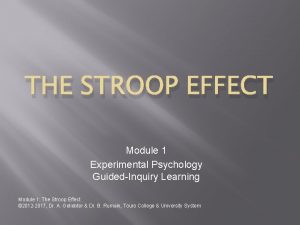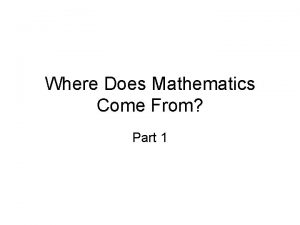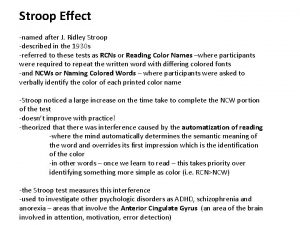THE STROOP EFFECT Module 1 Experimental Psychology GuidedInquiry










- Slides: 10

THE STROOP EFFECT Module 1 Experimental Psychology Guided-Inquiry Learning Module 1: The Stroop Effect © 2012 -2017, Dr. A. Geliebter & Dr. B. Rumain, Touro College & University System

Motivation � Suppose we have two signs. One sign has three blue Xs. The second sign has the letters R-E-D written in blue ink. XXX � � RED In which case is it easier to say that the color of the ink is blue? A question like this motivated Stroop in 1935 to do his famous experiments on interference in color naming.

Activity 1: Experiment 1 Method: � Subjects: Subjects were college students. � Procedure: Subjects were asked to perform two tasks: (1) To name the colors of solid squares presented to them. For example, a subject is shown a red square and is supposed to say “red”. This is the naming color (NC) test. (This is condition NC in Table I below. )

Activity 1: Experiment 1 (2) To name the color of the ink in which a word was printed. For example, when the word “red” was written in blue ink, RED the subject was supposed to say “blue”: In the table below, this condition is referred to as NCWd, which stands for “Naming test where the color of the print and the word are different. ”

Results The results of this experiment are given in Table I below. � “n” refers to the number of subjects. � “NCWd” refers to the condition where the color of the print and the word are different, and the subject should name the color of the print. � “NC” refers to the condition where the subject is shown solid-colored squares and should name the color of the square. � “σ ” refers to the population standard deviation. � “D” refers to the difference in the mean reaction times for NC and NCWd tests.

Table I Mean time (in seconds) for naming 100 colors presented in squares and printed in words naming other colors Sex n NCWd σ NC σ D Male 29 111. 1 21. 6 69. 2 10. 8 42. 9 Female 71 107. 5 17. 3 61. 0 10. 5 46. 5 Male and Female 100 110. 3 18. 8 63. 3 10. 8 47. 0 What are some questions we might ask ourselves? Write down your team’s questions on the handout.

Table I Mean time (in seconds) for naming 100 colors presented in squares and printed in words naming other colors Sex n NCWd σ NC σ D Male Female Male and Female 29 71 100 111. 1 107. 5 110. 3 21. 6 17. 3 18. 8 69. 2 61. 0 63. 3 10. 8 10. 5 10. 8 42. 9 46. 5 47. 0 Here are questions we might ask: 1) Is there a difference between males and females in the time it takes to perform the NC and NCWd tests? 2) Is the difference significant? How can you tell? Which statistical test would you use? (Write down your team’s answers on the handout. )

Activity 2: Experiment 2 � � � Stroop used five colors: red, blue, green, brown, and purple. He made a list of color names. No word was printed in the color that it named. So a word in red ink would never say “Red”. It would always say a color other than red to create conflict when the subject had to name it. For example, we could have the following: PURPLE � What is the conflict created? Why is there a conflict? (Write your answers on the Team handout. )

Table II Below in Table II are the mean reaction times (in seconds) showing how long it took for the subject to read RCNd and RCNb. � � RCNd = Reading color names where the color of the print and the word are different RCNb = Reading color names printed in black ink Mean time (in seconds) for reading 100 names of colors printed in colors different from that named by the word and for 100 names of colors printed in black Sex N RCNd σ RCNb σ D Male 14 43. 20 4. 98 40. 81 4. 97 2. 41 Female 56 43. 32 6. 42 41. 04 4. 78 2. 28 Male and Female 70 43. 30 6. 15 41. 00 4. 84 2. 30

Table II Mean time (in seconds) for reading 100 names of colors printed in colors different from that named by the word and for 100 names of colors printed in black Sex Male Female Male and Female N 14 56 70 RCNd 43. 20 43. 32 43. 30 σ 4. 98 6. 42 6. 15 RCNb 40. 81 41. 04 41. 00 σ 4. 97 4. 78 4. 84 D 2. 41 2. 28 2. 30 Questions: 1. What can you infer from the table? 2. Is there a difference between males and females in the time it takes to perform the RCNb and RCNd tasks? 3. Is it significant? How can you tell? 4. Which statistical test would you use? (Write your answers on the Team Handout. )



















